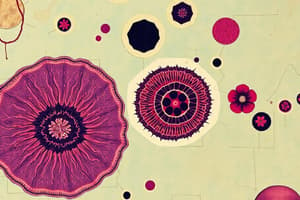Podcast
Questions and Answers
What is histology?
What is histology?
The study of tissue structure.
Which factors can lead to changes in tissues?
Which factors can lead to changes in tissues?
- Development
- Growth
- Aging
- All of the above (correct)
Skeletal muscle cells enlarge because they increase in size in response to exercise.
Skeletal muscle cells enlarge because they increase in size in response to exercise.
True (A)
What are the four major types of tissues in the human body?
What are the four major types of tissues in the human body?
What is the general characteristic of epithelial tissue?
What is the general characteristic of epithelial tissue?
Which type of epithelium is suited for diffusion and functions in gas exchange?
Which type of epithelium is suited for diffusion and functions in gas exchange?
What is the function of simple cuboidal epithelium?
What is the function of simple cuboidal epithelium?
What type of cells are found in simple columnar epithelium?
What type of cells are found in simple columnar epithelium?
Match the types of epithelial tissue with their functions:
Match the types of epithelial tissue with their functions:
What is the primary function of glandular epithelium?
What is the primary function of glandular epithelium?
What type of epithelium is designed to distend and return to normal size?
What type of epithelium is designed to distend and return to normal size?
Flashcards are hidden until you start studying
Study Notes
Histology and Tissue Structure
- Histology is the study of tissue structure and organization within organisms.
- Understanding tissue structure is critical to grasping how cells form tissues, which combine to create organs and systems.
- Tissue changes may occur due to development, aging, trauma, or diseases, such as cancer.
- The arrangement of cells in a tissue is specialized to perform specific functions.
- Tissues are classified into four major types, each with diverse functions.
Epithelial Tissues
- Epithelial tissue covers organs and body surfaces, and is anchored to a basement membrane.
- Composed of tightly packed cells, epithelial tissues contain minimal intercellular materials and generally lack blood vessels.
- Epithelial tissues renew frequently, undergoing constant replacement.
Types of Epithelial Cells
-
Simple Squamous Epithelium
- Comprised of a single layer of flattened cells.
- Facilitates diffusion and gas exchange in lungs; lines blood and lymph vessels, and body cavities.
-
Simple Cuboidal Epithelium
- Made up of a single layer of cube-shaped cells with central nuclei.
- Functions in secretion and absorption, particularly in kidneys and glands.
-
Simple Columnar Epithelium
- Formed by elongated cells with nuclei near the basement membrane; may have cilia.
- Lines the uterus, stomach, and intestines; involved in protection, secretion of digestive fluids, and nutrient absorption.
- Contains microvilli in intestines to increase absorption surface area; includes mucus-secreting goblet cells.
-
Pseudostratified Columnar Epithelium
- Appears layered due to varied nuclear positioning but is a single layer of cells.
- May have cilia and goblet cells; lines respiratory tubes to sweep away debris.
-
Stratified Squamous Epithelium
- Composed of layers of flattened cells to provide protection.
- Found in the outer skin, mouth, throat, vagina, and anal canal.
- The outer skin cells undergo keratinization, a process absent in moist areas like the throat and vagina.
-
Stratified Cuboidal Epithelium
- Made up of 2-3 layers of cuboidal cells lining lumens in mammary, sweat, salivary glands, and pancreas.
- This multilayer configuration offers greater protection.
-
Stratified Columnar Epithelium
- Consists of several cell layers and is located in the vas deferens, part of the male urethra, and parts of the pharynx.
-
Transitional Epithelium
- Designed for distension, it allows the urinary bladder to expand and contract while preventing urine diffusion.
-
Glandular Epithelium
- Comprises cells that produce and secrete substances into ducts or fluids.
- Exocrine glands secrete products into ducts, while endocrine glands secrete directly into body fluids and blood.
Studying That Suits You
Use AI to generate personalized quizzes and flashcards to suit your learning preferences.




